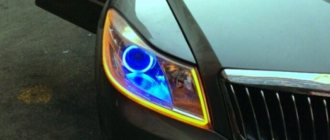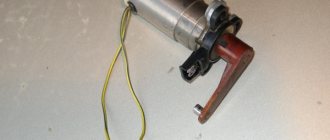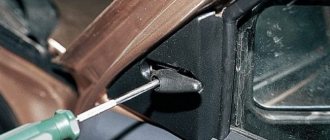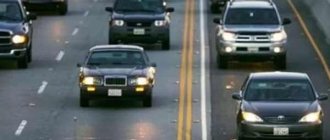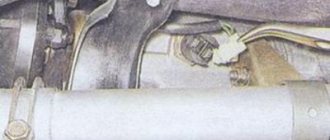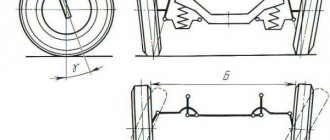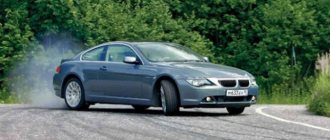Comments: no Published: 04/08/2016
Rating:
Tags:Philips ledDaytime running lightsLED backlightLED running lights
The fact that daytime running lights are currently the most popular component of vehicle exterior lighting has a significant impact on reducing the number of road traffic accidents and incidents.
Daytime running lights are required in order to express and highlight against the background of other vehicles during daylight hours. This significantly increases the car's catchiness and thereby, of course, increases the safety of the people in it.
Driving a car during the day requires turning on the DRLs.
However, before you begin the process of installing daytime running lights, it is imperative to find out what rules regarding this type of installation are provided for by the Traffic Regulations and GOST. Below you will find all the nuances and features that you need to know in order not to get caught by the traffic police. The Daytime Running Lights Law of 2011 requires all car owners to drive with active headlights during daylight hours. It is also worth noting that the concept of DRL now extends to both fog lamps and low beam lamps.
Fines for running lights
The requirements for the use of DRLs are specified in the traffic regulations and any violations may result in a fine. Everything is quite simple here:
- When driving without running lights or another permitted option, a fine of 500 rubles is imposed. Moreover, if the violation is repeated periodically, the amount will not change; a receipt for 500 rubles will still be issued.
- If a lamp burns out in one of the light sources or a diode in an LED element fails, you will also have to pay a fine of 500 rubles. Everything here is the same as in the paragraph above; if the violation is repeated, the amount will not increase.
- Another reason for a fine (also in the amount of 500 rubles) is severe pollution of light sources. If you drive on the highway for a long time in winter or when a lot of dirt rises from the road, the DRLs become so dirty that they are practically invisible. Therefore, from time to time it is worth stopping and checking this point.
- If the driver has not had any traffic violations over the past six months, the inspector may limit himself to a warning. It is worth remembering this so that when communicating, you can focus on the fact that there have been no violations for a very long time.
With new cars everything is much simpler, since DRLs are included in the headlight design.
By the way! If you pay the issued fine within the first 20 days, a 50% discount applies. That is, when the driver does not delay payment, he can save 250 rubles, which is also important.
Clarifications on the new rules for car tuning from February 1, 2021
In the summer of 2022, a complete transition to electronic PTS is planned. The technical equipment passport will allow you to save all information about motorists in the traffic police databases, which will allow citizens to quickly find out the entire history of the owners when purchasing a used vehicle.
Ad block:
In addition, the convenience of an electronic passport lies in the fact that you can enter more detailed information about the car: maintenance, repairs performed.
In 2022, the Government approved a bill that allows traffic police officers to prosecute drivers who have committed an offense recorded by third parties. Especially for this, in 20148 the “People’s Inspector” application will be announced, through which ordinary eyewitnesses will be able to send information about traffic violations committed by drivers to the traffic police.
In this case, traffic inspectors will not need to draw up decisions to hold the driver accountable for violations of traffic rules and issue a protocol. To punish the perpetrator, it will be sufficient to have a video recording of the violation.
At the beginning of 2022, a new form of compulsory motor third party liability insurance policy will appear, which additionally provides a special code with which you can easily obtain all the information about the contract concluded with the insurance company. All information will be available in real time on the website of the Russian Union of Auto Insurers.
Using this form will allow you to use the application to obtain the following information about the agreement between the insurer and the policyholder:
- Name of the insurance company.
- Series, number and date of issue of the insurance policy.
- Start date and end date of the vehicle use period.
- Information about the policyholder.
- Information about the owner of the insured vehicle.
- Information about persons who are allowed to drive the insured car (list of drivers or an indication of their unlimited circle).
The introduction of this new form is aimed at reducing the number of counterfeit MTPL policies.
The bill being considered by the Government contains amendments stating that compulsory carrier insurance, which is currently taken out by the owners of buses and other public vehicles, must also be provided to taxis.
The law on compulsory carrier liability insurance has been in force in Russia since 2013.
In accordance with the requirements of this regulatory act, the carrier that transports passengers must insure its liability to them.
Traffic rules for DRL
In the Road Traffic Rules of the Russian Federation, the basic requirements for running lights are stated in paragraph 19 . It is worth highlighting only important information:
- Clause 19.5 states that when driving during daylight hours, the car must have low-beam headlights or daytime running lights, if they are included in the design.
- Clause 19.4 states that fog lights can be used as an alternative to DRLs or low beams in the daytime.
If we consider the comments to the traffic rules and study the recommendations of experts, we can highlight the following options for lighting devices used in the daytime:
- Standard running lights.
- Low beam.
- High beam headlights operating at 30% power.
- Fog lights.
- Turn signals always on.
Fog lights are allowed as an alternative to DRLs in Russia, but prohibited in Europe.
Different models have specific features for using DRLs, so it’s worth figuring out which option will be optimal. It is necessary to remember that driving with traffic lights is a violation of traffic rules, as is driving with running lights at night. They cannot act as a replacement for low beams in conditions of poor visibility.
Related video: Running lights instead of low beams.
Advantages and disadvantages of DRL
The debate continues on the Internet - is it worth installing “daylight”, or is it pampering and a tribute to fashion?
Proponents make the following arguments:
- Electricity consumption compared to halogen lamps is negligible;
- The service life of low beam lamps increases, fuel is saved;
- The car is better visible in bright sunshine;
- The car seems “cooler”, especially if the LEDs are built into the headlights.
Opponents of installing non-standard lighting devices are guided by other principles:
- Generators of modern cars are designed for standard load, including lights on. In addition, on many models, the factory DRL (day running lights) turns on the lamps at 70% filament, so there is no talk of a reduction in service life.
- The lamps themselves cost money, but do not last forever. And for this amount you can buy low beam lamps for 10 years in advance. And gasoline savings are within the measurement error.
- From a design point of view, someone who understands modifications will immediately see a foreign design. And those for whom all cars are the same will not pay attention to the lights.
Many motorists who installed DRLs on their own did not read the Rules. Therefore, it is not uncommon to see a “UFO” on the road with low beams on and DRLs operating at the same time. And this is a traffic violation. In which, according to tradition, the “evil inspector” will be to blame, but not the skilled car enthusiast.
There are no ready-made solutions to the issue of car tuning; everyone improves a car to their own taste. Or leaves the factory equipment.
The main thing is that the decorations do not affect traffic safety, do not blind oncoming drivers and pedestrians, comply with traffic regulations, and do not provoke emergency situations.
Be careful and careful on the roads!
Requirements for DRL according to GOST
In order not to have to deal with regulatory documentation, you can study the basic GOST standards, collected in one section:
- The vehicle must use two identical light sources . You cannot place one element.
- The minimum distance between DRLs should not be less than 60 cm . It is this parameter that most often causes difficulties, since the width of passenger cars is small and there is not much space for installation. It is necessary to take measurements in advance to choose the optimal location option, if possible.
- The height of the location is at least 25 cm from ground level and no more than 1.5 m (requirements for buses, freight and large vehicles). For this reason, running lights cannot be installed on the lower edge of the bumper.
- The light source should be located no further than 40 cm from the edge of the machine. At the same time, there is no minimum indicator; you can set it anywhere, which is also worth remembering.
- When installed, the emitter is oriented so that the light is directed straight forward. It cannot be placed upwards, downwards or to the sides.
- Only sources with white or yellowish light are suitable for use as DRLs. Colored options are not allowed. At the same time, there are also requirements for brightness; the minimum should not be less than 100 candelas, the maximum should not be higher than 400 cd .
- The daytime running lights should light up automatically when the ignition is turned on. But it is not forbidden to display them on a separate button; the main thing is not to forget to turn on the light at the beginning of the movement.
- The scattering angle in the horizontal plane (outward and inward relative to the position of the DRL) should not exceed 20° . And the angle in the vertical plane is limited to 10°.
It is difficult to check the brightness of equipment. Therefore, we can assume that the running lights should be clearly visible - at least twice as bright as their dimensions.
This diagram will allow you to clearly see the basic standards for installing DRLs on a car.
Installing daytime running lights
The first candidates for installation were the largest devices, namely 5 LEDs. Yes, yes, it is Philips LED daytime lights, and not LED DayLight 8, that have the largest dimensions. However, there is no need to be alarmed in advance; they are only large in relation to other samples. However, having tried the “five” on all editorial cars, we were able to find a place for it on only two cars, namely the Renault Logan of the first phase and the Ford C-Max. It was not possible to attach them to any other car and maintain the installation dimensions. More precisely, one of the dimensions is 60 cm between the inner edges of the lanterns. By the way, as a rule, this parameter is the most difficult to maintain. Installation with markings and stops for photographic recording of the entire event required about 2.5 hours.
Next in line was a kit whose dimensions were significantly smaller. We are talking about Philips LED DayLight 4 LED daytime running lights, that is, 4 LEDs. The small size of this device made it possible to install them on a much larger number of cars, but we decided to implement them on the Hyundai Getz. However, when installing the DRLs we encountered one difficulty. Even before installation, in order to better measure the location, it was decided to try on these lights along with the installation bracket. One click, and... 15 minutes of problems in separating the lights themselves and the mounting bracket were provided to us. No matter how hard we tried, we couldn’t separate them as easily. The fastening of the bracket to the lamp itself is done very well and absolutely eliminates spontaneous disconnection. In this regard, advice: do not do this until the last moment, that is, until the final installation. Otherwise there were no problems. The “plus” wire from the switching unit to the “plus” of the battery, the “minus” to the “minus”, the on/off control wire - in parallel with the “plus” of the side lights near the headlight - and that’s all. In general, the installation, not counting problems with disconnection, took no more than two hours.
Daytime running lights Philips DayLight 8, although it consisted of eight LEDs, was still not much larger than the “four” in size, and also differed favorably from the previous two in the following parameters. Firstly, the angle at which the visibility of these DRLs is maximum has been increased by 20 degrees horizontally, which makes the car visible even when looking at it not head-on, but from three-quarters. Secondly, the “eight” can also work in side lights mode. That is, not completely turn off, but fade out. By the way, it is precisely for this reason that the delivery set includes two decoys that are inserted instead of marker lamps. Many modern cars have a control unit for failed lamps, and so that this system does not worry, these tricks are used. But, we think, no one will use them here. And yet the European approach is felt even in this. The installation of the “eight” is no different from the installation of other kits, and therefore it did not take any more time than expected by the manufacturer. By the way, due to their small dimensions, they can be installed on a very large number of cars. For a lot, but not for everything.
How to install correctly
Many drivers do not know how to install and select running lights so as not to be fined for violating installation rules. It’s not difficult to understand the issue; first of all, you need to take into account the location requirements, and it’s also worth remembering these tips:
- You should only choose those options that are certified in the country and can be used as DRLs. Usually, information about this is always on the packaging or there is a supporting document. You should not order dubious products from China, as they may not meet the standards.
- It is best to use models with a control unit that automatically turns on the light when the voltage in the on-board network rises above 13 V. This option is connected directly to the battery, which simplifies the system and makes it reliable.
- Studying the connection diagram included in the kit is mandatory. The most commonly used is the standard option shown below. It can be used to understand the work even for those who have no experience in installing DRLs.
- The location is selected, it all depends on the design of the front part of the car and the layout of the lighting equipment. It is important to securely secure the light sources so that they are directed straight ahead. It is better to select a model for your car so that the appearance after installation is attractive.
The DRL installation diagram is simple, everything you need is included in the kit.
Types of LED lamps for DRLs
After you have studied the rules for installing running lights on a passenger car, all that remains is to choose the right LED DRL lamps. They are divided into several categories:
- Single lensed (they are also called “eagle eye” or “dragon eye”). They usually fail quickly, and the wiring and aluminum alloy housing do not last even several months. The only exception is the “dragon eyes” from Hella.
- On a rubber band. Such products are also not recommended as DRLs, since they do not have a radiator and aluminum boards, so they can only be installed in the car interior as illumination under the feet. However, such lamps are characterized by good sealing. Trusted and well-known manufacturers do not yet sell such lamps (although they have announced the beginning of the development of such models).
- In plastic cases. Such lamps are covered with plastic “glass”, due to which the LEDs become very hot. Even a company like Philips has not yet been able to solve this problem.
- In glass cases. These are the highest quality running lights, which are covered with real glass combined with aluminum. The characteristics of such lamps are the best, however, the price is considerable.
- In the form of plates on SOV diodes. Despite the interesting configuration, this type of DRL is considered the most useless and absolutely does not meet GOST. The fact is that such lamps lack protection from moisture and dust. You won't find a radiator either. The service life of such elements hardly reaches several months, and the power of the light beam allows them to be used only as a backlight, and even then, not the strongest.
- In foglights (lensed headlights). Very high quality and long-lasting DRLs. These elements have almost everything you need: 10 W LEDs, lensed glass, fasteners and, of course, an aluminum housing.
As you can see, despite a fairly large selection of different LED elements, only a few types are suitable for DRLs: those in glass housings and diodes installed in fog lights.
